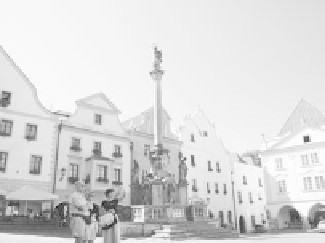Travel Reference
In-Depth Information
right, dedicated by the Czech freedom fighters, commemorates the
first Czechoslovak president, Tomáš Garrigue Masaryk (in office
1918-1934; see sidebar on page 106). The bust on the left recalls
Masaryk's successor, Edvard Beneš (in office 1934-1948; see side-
bar on next page).
• Walk another block down the main drag, until you reach steps on the
left leading to the...
Church of St. Vitus:
Český Krumlov's main church was built
as a bastion of Catholicism in the 15th century, when the Roman
Catholic Church was fighting the Hussites. The 17th-century
Baroque high altar shows a totem of religious figures: the Virgin
Mary (crowned in heaven), St. Vitus (above Mary), and way up
on top, St. Wenceslas, the patron saint of the Czech people—long
considered their ambassador in heaven. The canopy in the back,
while empty today, once supported a grand statue of a Rožmberk
atop a horse. The statue originally stood at the high altar. Too
egotistical for Jesuits, it was later moved to the rear of the nave,
and then lost for good. As you listen to the river, notice the empty
organ case. While the main organ is out for restoration, the cute
little circa-1716 Baroque beauty is getting plenty of use (see photos
of the restoration work on the far wall, church open daily 10:00-
19:00, Sunday Mass at 9:30, tel. 380-711-336).
• Continuing on Horní street, you'll come to the...
Main Square (Náměstí Svornosti):
Lined by a mix of
Renaissance and Baroque homes of burghers (all built upon 12th-
century Gothic foundations), the main square has a grand charm.
There's continuity here. Lékárna, with the fine red Baroque facade
on the lower corner of the square, is still a pharmacy, as it has been
since 1620. McDonald's tried three times to get a spot here but
was turned away. The Town Hall flies the Czech flag and the town
flag, which shows the rose symbol of the Rožmberk family, who
ruled the town for 300 years.
Imagine the history that this square has seen: In the 1620s,
the rising tide of Lutheran Protestantism threatened Catholic
Europe. Krumlov was a seat of Jesuit power and learning, and the
intellectuals of the Roman
church allegedly burned books
on this square. Later, when
there was a bad harvest, locals
blamed witches—and burned
them, too. Every so often, ter-
rible plagues rolled through
the countryside. In a nearby
village, all but two residents
were killed by a plague.
But the plague stopped



















